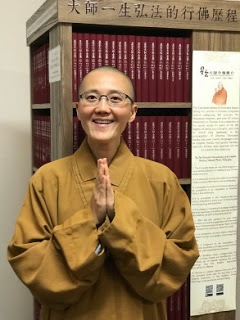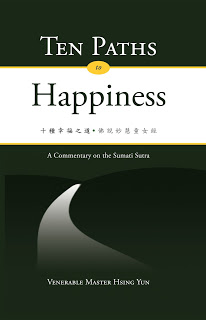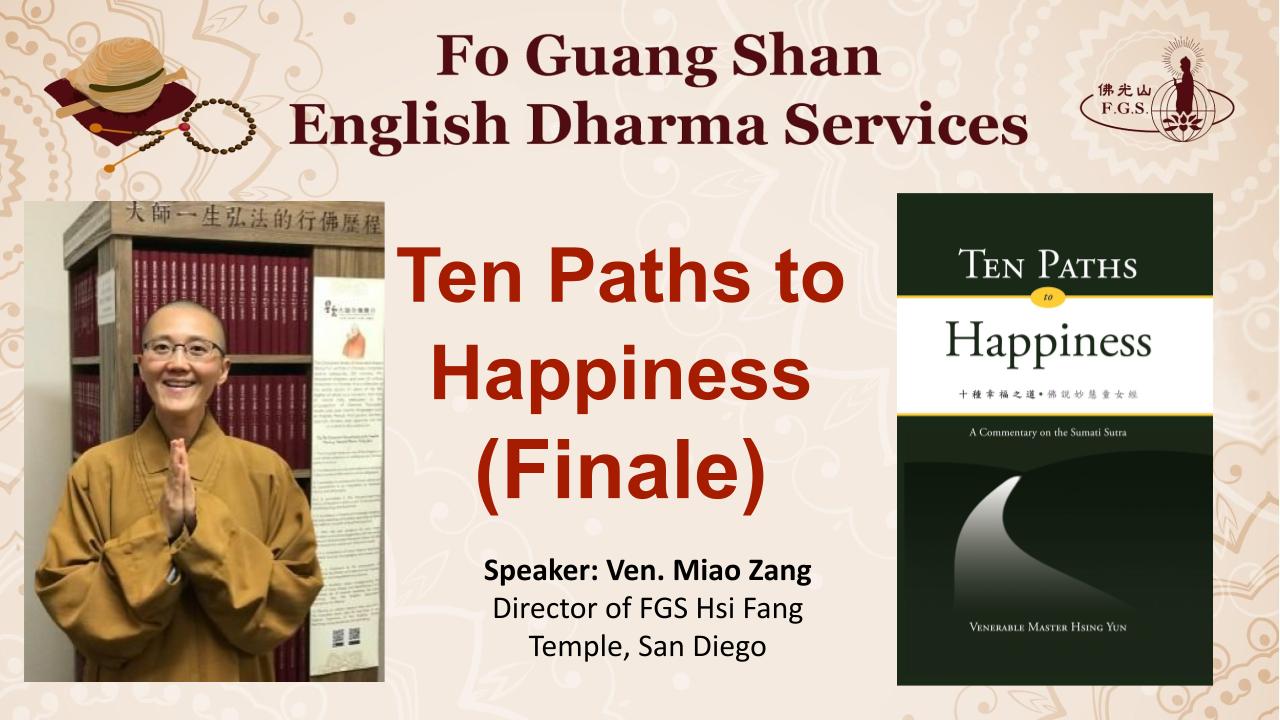
Speaker: Venerable Miaozang
FGS Hsi Fang Temple, San Diego
I. Introduction
Auspicious greetings to all Dharma friends around the world. Thank you for tuning in to a new series of Fo Guang Shan English Dharma Services. I’m Miaozang from Fo Guang Shan Hsi Fang Temple, San Diego, California. This will be the last time for us to journey together in the pursuit of Ten Paths to Happiness. How is everyone’s progress? I hope everyone is applying the recommended methods by the Buddha and experience great happiness. ☺
A quick recap of last week’s 8th and 9th paths to happiness. We have learned that to remove Dharma obstructions, precepts are the foundation of liberation and we venerate the initial intention and give rise to the mind of all wisdom. For us to avoid the Mara in our practice, we should completely understand that Dharma nature is equal and we should always be diligent in our cultivation.
II. The Tenth Path to Happiness
On the tenth path to happiness, Sumati asked the Buddha the question on how to ensure that they will be greeted by the Buddhas at the end of life?
The Buddha replied, “Once again, Sumati, bodhisattvas use four methods to ensure that they will be greeted by the Buddhas at the end of life. What are the four?
- First, give gifts to satisfy the needs of others.
- Second, produce a deep faith in all wholesome teachings.
- Third, offer all bodhisattvas their ornaments.
- Fourth, diligently make offerings to the Triple Gem.”
In this life, no matter how we live, we are very fortunate to be born as humans, having the conscience, the ability to learn, and constantly improving ourselves. From the moment we took our first breath, growing up, experiencing under the weather moments, to our last breath, we accumulate experiences and cultivated different causes and conditions in life. With faith, we are conscious of our actions, speech, and thoughts. We strive to plant the wholesome causes and conditions. When we practice righteously, we make positive affinities with others and generate more merits. When the moment comes for us to move on, we always hope that we can continue our journey to pursue our practice with the Buddha until perfection. We have to start our practice now for us to come to that day. It is just like saving money in our bank to have sufficient funds to immigrate or move to another better place. Thus, in this path to happiness, let us learn more about the suggested methods by the Buddha.
1. Give Gifts that Satisfy the Needs of Others
In the whole Sumati Sutra, the practice of giving and offering comprises of 11 out of the 40 recommended methods in the pursuit of the ten paths to happiness. Starting from the first path to happiness, we learn to make Buddha images, to the second path to happiness where we learn the four methods of giving. We continue to practice giving with wholesome thoughts, offering to the Triple Gem, and making Tathagata images with sincerity and respect. Giving is one of the practices that even the Buddha continuously practice until even after enlightenment. Thus, it takes time for us to make it a habit and overcome the greed in our mind. With this in mind, we know that perfection in giving is not easy but it is possible.
In this method, the Buddha shares with us how we can give gifts to meet others’ needs. One of the ways is to observe and understand the causes we can give and the condition for others to receive. When we go along with the causes and conditions, we can fulfill others’ needs.
Looking at the Fo Guang Shan Sangha community, we have over 1,300 monastics. People often ask Venerable Master Hsing Yun how he can meet the needs of so many monastics. Venerable Master replied saying that he treats everyone kindly and says “yes” and “okay” whenever possible. He hardly ever says “no” and if he were to say that, he will always provide an alternative.
There was once a first-year Buddhist College student who liked to eat eggs a lot. When she was in the Buddhist College, one of her main struggles was not having eggs. She was unable to adjust to the diet at Fo Guang Shan and having trouble staying focus in her practice. Knowing this, Venerable Master asked his attendant to bring her to a diner outside the monastery to have various dishes with eggs. She was so delighted and felt so satisfied and happy after that. From that day onwards, the student focuses so well on her studies as well as her practice. Venerable Master’s way of fulfilling one’s needs is by being flexible and going along with the conditions. There is a Buddhist saying “Remain flexible yet unchanging; remain unchanging yet flexible.” When people go along with conditions and let go of worries, happiness will always follow. Venerable Master exclaims that “Happiness is an especially wonderful gift to give to others. Happiness is something that grows when it is shared with others.”
Another real-life story that I would like to share is about giving a gift that not only satisfying one’s needs, also one’s life. The recent local news shared about a boy named Noah, 7-year old, who was battling sickle cell disease which relates to the red blood cells carrying oxygen to part of the body. If he were at a high altitude and very cold weather, it will trigger a pain crisis and other illnesses within his body. Ultimately, a bone-marrow transplant is the only cure for this young boy. That was where his big brother Blake, 10-year old, stepped in. There was a 1-in-4 chance he would be a match and he turned out to be a perfect match. Their parents were so touched by what Blake is willing to do for his brother. Noah underwent three different chemotherapies, platelets, and blood transfusions plus tennis that got him back on his feet. This gift that his brother gave is beyond the needs of others. It is a bodhisattva’s gift of life.
2. Have a Deep Faith in All Wholesome Teachings
The Buddha’s Teachings are not created nor invented. The Teachings are the realization of the reality of life. Understanding the Teachings is like seeing the true form of the world. When the Buddha realized the Truth on Dependent Origination, he has an insight on all existence comes to be, changing, or ceased to be with the constant flux in the causes and conditions. When we comprehend this reality, we try our best to put together the right causes and conditions to have something to work as planned. Of course, there are still many causes and conditions that are not within our control. Yet, we can work on the ones that we can manage.
Many Buddhists pray to the Buddhas and Bodhisattvas every day. Why do we pray even though we know that we have to cultivate ourselves to see the difference? Let me share with you a story. There was one mother who brought her daughter to the temple to pray everyday. As the daughter grew up, one day, she asked her mother, “Why do we pray to the Buddha? The Buddha will not just grant us what we pray for. Just like what you remind me that I still need to work hard to see the changes.”
“Well, you are right. We still need to work hard and yet praying helps us grow our faith and self-confidence. Also, we pray for other uncontrolled conditions to go with what we pray for,” her mother replied.
When we pray, we remind ourselves of the Buddha, giving us confidence in our practice. When we pray, we are chanting or reading the Buddha’s Teachings or sutras, which helps to deepen our daily understanding and contemplation. With these reminders of the Buddha’s practices, we constantly try to improve ourselves to be more understanding, to be kind, improve our people skills in forming positive connections with others, practice empathy, to be clear in mind, and to be compassionate to others as well as ourselves.
Venerable Master says, “You do not have to believe in the Buddha, but you must believe in the law of causality. You can do without Buddhism, but you can never do without compassion.” Thus, it is crucial to have deep faith in the wholesome Teachings.
3. Offer All Bodhisattvas Their Ornaments
Let us start by defining the words Bodhisattva and ornaments. Bodhisattvas in this context are referring to those who vow to practice the Bodhisattva path. Ornaments, are not only a treasury of ornaments but can also be the practices that beautify our lives. When we support all those who vow to practice the bodhisattva path and commend their intentions, it is also offering all Bodhisattvas their ornaments. Also, everyone can support each other in this challenging Bodhisattva’s practice.
The “Great Actions and Vows of Samantabhadra Chapter “of the Flower Adornment Sutra says, “The perfection of patience is an ornament.” Patience is also an ornament that can beautify our lives.
When we cultivate patience for living and existing, it allows us to endure the hardships, pleasures, hunger, thirst, suffering, and other non-ideal experiences in life. There’s a saying “A moment of patience in a moment of anger saves you a hundred moments of regret.” Practicing patience is not suppressing our emotions. Being patient is to recognize the causes and conditions, wholesome and unwholesomeness, advantages, and disadvantages.
One of my recent experiences with patience was when our temple was undergoing building maintenance with exterior painting. Overall, the company did a good job. The temple looks new and clean now. However, during the process of painting, whenever I inspected the areas, I would find pieces of bright orange masking tapes here and there on the wall. Some places were also missed and not painted. I constantly reminded myself to be patient as I communicated with the project manager, Jerry. On the last day when they said they have completed, I did the final checking. I suddenly thought of checking the roof. So, I went up the tight ladder, making sure to step carefully on the roof tiles. I found out that the two flat areas on top were not painted. Only the sides were painted. I could feel that the anger within my mind was rising. Luckily, I have a habit of asking myself “Am I breathing?” Which brought my awareness to the present and prompted me to be patient. It was not easy but it took some efforts and time to clear my mind. There is a saying of “Endure for a breath and the storm settles. Take a step back and the sky is limitless and the ocean is boundless.” I took some photos and shared with Lynette, who is my bodhisattva in helping me draft a friendly reminder email, instead of a straight-forward one, to let the company knows. Everything turned out well.
Patience is solving problems. Whether a situation is good or bad, patience can make big matters small, and small matters non-issues. Thus, the ornament of patience is also important and we should all adorn ourselves with this.
4. Diligently Make Offerings to the Triple Gem
The last method that the Buddha taught us is to diligently make offerings to the Triple Gem, which refer to the Buddha, the Dharma, and the Sangha. Offering to the Buddha is to show our respect and a token of appreciation for the Teachings the Buddha shared. Offering to the Dharma is to support the sharing and continuous Teachings in this world. Offering to the Sangha are supporting the monastics who promote the Truth, serving the society in spreading compassion and wisdom. Most importantly, by offering to the Triple Gem, we dedicate all wholesome roots to all sentient beings as we cultivate merit in cultivating positive connections with them. As we continuously deepen our affinity with the Triple Gem, we slowly nurture the Bodhi seed in our mind. Gradually, the Bodhi seed germinates and cultivate more wholesome deeds life after life. This will eventually lead us to realizing supreme enlightenment with all sentient beings.
III. Conclusion
Happiness is what we are all seeking for. The Ten Paths to Happiness of the Sumati Sutra shows us the Buddha’s self-experienced and proven methods to the long-lasting happiness, which is liberating ourselves from dukkha and the cycle to birth and death.
Before we conclude, let us have a quick review of the forty methods mentioned by the Buddha:
Q1: How does one attain an elegant, proper appearance?
- Do not give rise to anger when dealing with unwholesome friends.
- Tranquilly abide with great loving-kindness.
- Take deep joy in the true Dharma.
- Make Buddha images.
Q2: How does one attain wealth and nobility?
- Give timely gifts.
- Give without contempt or arrogance
- Give joyfully.
- Give with no expectation of reward.
Q3: How does one protect one’s family from destruction?
- Skillfully abandon divisive language.
- Persuade sentient beings marred by wrong view to abide in right view.
- Protect and ensure the continuation of the true Dharma.
- Teach all sentient beings to attain Buddhahood.
Q4: How can one be reborn in the presence of a Buddha?
- Offer flowers, fruits, and powdered incense at Tathagata stupas and temples.
- Never bring harm upon others.
- Make Tathagata images and place them upon lotus thrones.
- Develop a pure faith in the enlightenment of all Buddhas.
Q5: How can one attain supernatural powers and able to travel anywhere?
- Do not hinder or become angry at the sight of others cultivating wholesomeness.
- Do not impede others from speaking the Dharma.
- Light lamp offerings at Tathagata stupas.
- Continuously cultivate all varieties of meditative concentration.
Q6: How can one live blamelessly?
- Make good Dharma friends without flattery.
- Do not be jealous of others’ accomplishments.
- When others achieve fame, be happy for them.
- While cultivating bodhisattva practices, do not slight or slander others.
Q7: How can one ensure that others will trust what one says?
- Always be consistent in your words and practice.
- Do not hide your wrongdoing from good Dharma friends.
- Do not seek fault in the Dharma one hears.
- Do not give rise to unwholesome thoughts towards those who speak the Dharma.
Q8: How can one eliminate obstructions to practicing the Dharma?
- Embrace the three categories of bodhisattva precepts.
- After hearing the profound sutras, do not slander them.
- See those who make their initial intention, then give rise to the mind of all wisdom.
- Treat all sentient beings with great loving-kindness and equanimity.
Q9: How can one avoid Mara?
- Completely understand that Dharma nature is equal.
- Give rise to diligence.
- Constantly contemplate the Buddha.
- Dedicate the merit from all wholesome roots.
Q10: How can one be greeted by Buddhas upon death, hear the Dharma, and be free from suffering?
- Give gifts to satisfy the needs of others.
- Produce a deep faith in all wholesome teachings.
- Offer all bodhisattvas their ornaments.
- Diligently make offerings to the Triple Gem.
The Buddha provided four methods of practice for each question asked by Sumati. To conclude, I would like to share the below four points:
1) Buddhism as “Do It Yourself” (DIY)
All the practices we learn from the Buddha have to be put into practice or do it yourself (DIY). It is because everything is an effect that arises from causes and conditions. When we cultivate the causes and conditions of wholesomeness, the wholesome effects will follow.
2) Giving as one of the key practices
As we learn all the forty methods in this sutra, many methods relate to giving. Not only do we establish positive connections with others through giving, but it is also an antidote to our greediness. The more we practice giving, the less attach we are, the lesser the ego we have, the more we care for others and gradually cultivate a mind with loving-kindness and without hatred.
3) Ambition is not barred by age nor gender
In Buddhism, what is small or young, men or women should not be taken lightly as everyone is equal in Inherent Nature and Buddha Nature. Sumati, an eight-year-old girl was Manjusri Bodhisattva’s teacher in the past lives. After learning this, Manjusri Bodhisattva stood up and bowed to Sumati. There is no ego or discrimination of age, status, or gender. Even in today’s society, many Gen Z (those who were born after 1996) stood up to do some good to help society, especially during this special time.
4) Uphold our initial intention and vows
Initial intention and vows are crucial in our daily practice as well as our path to Buddhahood. It is just like our compass in our practice, continuously aspiring to move forward in the journey of discovering and seeing the Truth of life. Similarly, Sumati who relied on the power of her vow to support her. It is the same power that enables Ksitigarbha Bodhisattva to endlessly help the suffering of beings in the lower realms. The Buddha has also vow to liberate those he could by sharing the happiness in the Dharma. So, no matter how challenging life is, always remember our initial intention and vows.
To see the Buddha is through the understanding of the Truth. We practice the Truth, following the causes & conditions in life, and gradually moving towards perfection in our practice. Lastly, may everyone continue to strive hard in life. May all receive the Dharma and grow deep, strong roots.
All the best to you all until we meet again. Let us “add oil” together! Omituofo.
Ten Paths to Happiness: A Commentary of the Sumati Sutra

By: Venerable Master Hsing Yun
Published by: Buddha’s Light Publications
We all want to be happy. Twenty-six hundred years ago a young girl named Sumati asked the Buddha ten earnest questions on how to live happily in this life and beyond, with the Buddha’s detailed responses revealing that happiness can only be attained when we understand the nature of the world and practice for the benefit of others. In Ten Paths to Happiness, Venerable master Hsing Yun explicates these precious teachings and presents the path to lasting happiness to all who wish for peace, harmony, equality, and liberation from suffering in this life.
Click here for more information.

